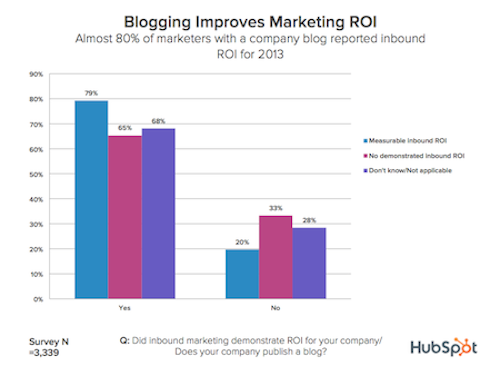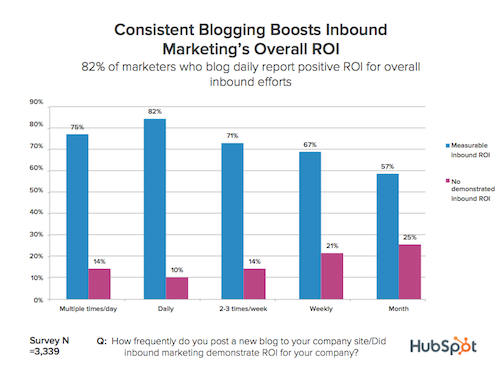A decade ago, before “blog” was a household word, it sounded more like a species of amphibian than a marketing tool, and businesses were skeptical of its value as an advertising medium. In 2013, however, it’s emerged as the most effective way for companies of any size to reach existing customers and obtain new leads, lending credibility to experts who’ve been banging the blogging drum for some time.
The numbers speak for themselves (see chart): businesses that publish a blog report higher returns on investment than those that don’t, signifying increasing trust in the medium as company “voice” that speaks directly to customers. This presents limitless opportunities for small businesses in decidedly “local” jurisdictions who already know their target audience and how to speak to them.
 But what are the best practices for starting a blog and keeping it consistently updated with fresh, original content that’s relevant to your business? That all depends on your time, creativity, available resources and the nature of your company: it’s important to use the tools at your disposal to create a “voice” or “persona” that represents your offerings without seeming pushy. An ideal way to do this is by staggering directly self-promotional posts between genuinely helpful or interesting posts that relate to your field. Below are two different examples of small business types and how they can respectively use blogging to generate interest and increase ROI (assuming a daily posting schedule):
But what are the best practices for starting a blog and keeping it consistently updated with fresh, original content that’s relevant to your business? That all depends on your time, creativity, available resources and the nature of your company: it’s important to use the tools at your disposal to create a “voice” or “persona” that represents your offerings without seeming pushy. An ideal way to do this is by staggering directly self-promotional posts between genuinely helpful or interesting posts that relate to your field. Below are two different examples of small business types and how they can respectively use blogging to generate interest and increase ROI (assuming a daily posting schedule):
Business-To-Customer Example: A Charter Fishing Boat
-
Monday: Post about seasonal fishing conditions in the region (Helpful)
-
Tuesday: Post about most recent fishing trip with photos of customers enjoying themselves (Interesting & Self-Promotional)
-
Wednesday: Post about most common types of fish caught (Interesting & Helpful)
-
Thursday: Post about most recent rates, specials and promotions (Self-Promotional)
-
Friday: Post a roundup of links to other fishing blogs with a brief description of each post being linked to (Interesting)
Business-To-Business Example: A Commercial Security & Alarm Company
-
Monday: Post about recent crime statistics in your area and the importance of an integrated security systems for businesses (Helpful & Self-Promotional)
-
Tuesday: Post about most recent alarm system models on the market and review by effectiveness (Interesting & Helpful)
-
Wednesday: Write a response to a topical industry-related consumer report and how your business has been affected by the findings of the report (Self-Promotional & Interesting)
-
Thursday: Post about recent developments in CCTV technology (Interesting)
-
Friday: Post about the costs associated with surveying/installing a security systems and link to your pricing page (Helpful & Self-Promotional)
 Though blogging five times per week may seem excessive to business owners with minimal time to spare, there’s a direct correlation between increased blogging frequency and higher return on investment, as evident by the chart on the left. Like most things in life, the more you put into blogging, the more you get out of it. if you’re candid and passionate, it’ll show.
Though blogging five times per week may seem excessive to business owners with minimal time to spare, there’s a direct correlation between increased blogging frequency and higher return on investment, as evident by the chart on the left. Like most things in life, the more you put into blogging, the more you get out of it. if you’re candid and passionate, it’ll show.
Excessive as this may sound to skeptics, thousands of small business owners with insufficient time or resources have taken to hiring professional bloggers as a scaled-down, cost-effective alternative to a full public relations campaign. While marketing yourself through social media platforms, SEO and a clean-coded website is still important, blogs provide a special type of value which says to your customers that you’re passionate about what you do, and that your passion is reflected in the quality of the products and/or services you offer.




